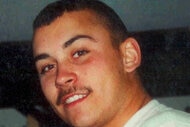Create a free profile to get unlimited access to exclusive videos, breaking news, sweepstakes, and more!
Did The 'Smiley Face Killers' Murder Hundreds Of Young Men, Or Is It Just A Myth?
Are the deaths the result of a gang of homicidal psychopaths or merely accidents?
It’s a tale that sounds like a piece of fan fiction from a “Creepypasta” forum or a spin-off of "The Purge" horror movie franchise. Its potential victims range anywhere from the 40s to the hundreds or — perhaps — none at all.
Are the deaths the result of a single killer, a gang of homicidal psychopaths or merely accidents? Is there a national murder conspiracy hiding in plain sight, or is the whole scenario a series of coincidences? A myth?
These are the questions surrounding the Smiley Face Killings.
The Smiley Face Killers, also known as the Smiley Face Murders or the Smiley Face Gang, is a theory that connects the drowning deaths of numerous college-aged men over the past 20 years. It claims their deaths were not accidents but murders possibly at the hands of an interstate network of serial killers. Their supposed kill zone stretches from New York City through the college towns of Upstate New York and along Interstate 94 to the upper Midwest. The theory contends that the serial killers are highly sophisticated and communicate with each other on the dark web.
The alleged victims were almost all athletic, white college students who were last seen leaving a bar in some degree of inebriation. The offered proof of a conspiracy rests in the narrow scope of both victims and locale, and the existence of smiley faces painted in the vicinities of where the men disappeared.
The Smiley Face murder theory begins with the February 1997 disappearance of 21-year-old Fordham University student Patrick McNeill. The former captain of his high school football team, according to The New York Times, McNeill went missing after a night of drinking at a Manhattan bar. His body washed up in Bay Ridge, Brooklyn, almost two months later. Though the New York City Medical Examiner would determine drowning as the cause of death, something didn’t sit right with McNeill’s family or NYPD Sergeant Kevin Gannon, who worked the case. They believed Patrick’s body showed signs of torture and that it was stored on land until being dumped in the river shortly before its discovery. Gannon, who had become close to the McNeills, promised them he wouldn’t rest until he found out what really happened to their son.
In 2001, Gannon retired from the New York Police Department and enlisted his old partner, Anthony Duarte, to continue his investigation into McNeill’s disappearance and death. Curiously, McNeill was the first of four mysterious deaths of young men in New York City over the following year, three of whom were discovered floating in the waterways around the five boroughs.
Gannon and Duarte soon began investigating the drowning deaths of other college-aged men around the country. Among them was the Halloween night 2002 disappearance of Chris Jenkins, a 21-year-old University of Minnesota student whose body was found floating in the Mississippi River four months later, still wearing his Halloween costume. Though police initially said his death was an accident or suicide, it was later reclassified as a homicide following statements from a jail-house informant.
According to The Daily News, it was while investigating Jenkins’ death in Minneapolis that Gannon and Duarte first noticed a smiley face grimly staring back at them where Jenkins was allegedly thrown into the river. They claim similar graffiti was found at 12 sites related to the other disappearances and later drowning deaths of college-aged men throughout the Upper Midwest. The smiley faces appeared to be drawn by different people, with some bearing devil horns, or grim messages written next to them. The Daily News quoted Gannon saying the smiley faces symbolized the killers "laughing at the police."
Gannon and Duarte ultimately claimed the drowning deaths of more than 40 young men were possibly interconnected murders. The deaths occurred in 25 cities and 11 different states, including New York, Ohio, Indiana, Illinois, Iowa, Wisconsin and Minnesota. Because of the disparity of locations, the differing smiley face graffiti, and sometimes overlapping timelines, Gannon and Duarte concluded the murders were the work of a group of killers.
“It would, in my view, be impossible to be one person,” Duarte would later tell CNN.
Gannon believed the “specificity of the group” indicated a formulated victim profile, which he described in an interview with Larry King as ages “19 to 23, highly intelligent, all very athletic young men.” Almost all the victims were white. The detectives surmised the killers may have been motivated by jealousy, or that the murders were committed as part of a gang initiation. At one location, they found graffiti that said “Sinsinawa,” which they believe was a clue left behind by the killers. Months later, the body of 24-year-old Matt Kruziki was found floating in the water off Sinsinawa Avenue in East Dubuque, Iowa.
Gannon and Duarte believed the victims were drugged while out drinking with friends, then abducted, in some instances tortured, and ultimately murdered. The bodies were then put into the frigid waters, where they would float away from the crime scene and theoretically rinse the victim’s body clean of incriminating evidence, such as finger prints or DNA, according to the retired detectives.
In the spring 2008, the Smiley Face Killer murder theory went national, and Gannon and Duarte toured the morning and late night talk show circuit discussing the case. Unfortunately, they felt their work did not lead to the local and national law enforcement community putting additional resources into an investigation.
Almost immediately, the FBI issued a “Statement Regarding Midwest River Deaths," which dismissed the “Smiley Face Murders” theory.
“To date, we have not developed any evidence to support links between these tragic deaths or any evidence substantiating the theory that these deaths are the work of a serial killer or killers,” it said, adding, “The vast majority of these instances appear to be alcohol-related drownings.”
Responding to those deaths within their own jurisdiction, the Minneapolis Police Department stated it could “neither confirm nor endorse the 'Smiley Face Murders' theory currently being publicized,” according to the Daily Herald.
In 2010, the Minneapolis-based Center For Homicide Research released a scathing 18-point refutation, entitled “Drowning the Smiley Face Murder Theory.” Among the holes it aimed to shoot through the theory was the proliferation of smiley face graffiti around the world, the inability to date when the graffiti was actually done in relation to the drownings, the fallacy that cold water necessarily “washes away all the evidence,” the relative infrequency of “homicidal drowning” and, sadly, the alleged frequency of drunk young men accidentally drowning in said regions. Ultimately, the CHR placed the blame on binge drinking, not a homicidal gang or group of killers.
“College students were drowning in the river long before most of these identified cases occurred,” it concludes. “And they will continue if we don’t take steps to control alcohol abuse within this college-aged group.”
Though the Smiley Face Killer murder theory hasn’t led to any arrests or definitive answers over the spate of drowning deaths of young men, it continues to hold the popular imagination, especially online. Blogs, social media posts and Reddit pages examine and obsess over the details of each case, the alleged crimes, and the potential victims while newspapers speculate whether more recent drownings might be tied to the ‘Smiley Face’ phenomenon.
Most notably, season 7 of the FX series “American Horror Story” is conjectured to have paid tribute to the theory with its deadly cult, which dressed as clowns and painted bloody smiley faces at the sites of their murders. According to Gannon and Duarte, the victim count may now be more than 350 young men.
[Photo: Courtesy of Dr. Lee Gilbertson]





























